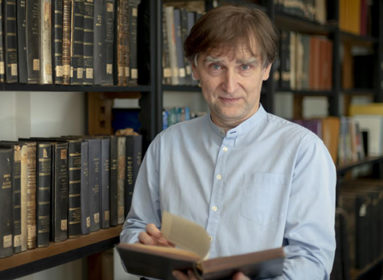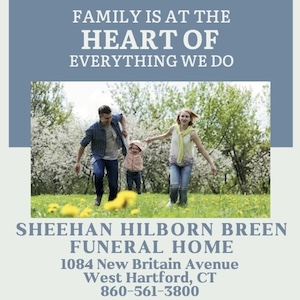
Connecticut’s “Golda” talks about Broadway’s new production of “Fiddler on the Roof”
By Judie Jacobson
NEW YORK, N.Y. — When it comes to Broadway legends there are few as enduring as the hit musical “Fiddler on the Roof.”
The original production, which opened on Broadway on Sept. 24, 1964, garnered ten Tony Awards, including a special Tony for becoming the longest-running Broadway musical of all time.
Fifty years later, “Fiddler” is back.
 Now in previews and set to open on Dec. 20, the new Broadway production is directed by Tony Award-winning director Bartlett Sher, who, by all accounts, brings a fresh vision to this theatrical masterpiece by Tony winner Joseph Stein and Pulitzer Prize winners Jerry Bock and Sheldon Harnick. The new production stars Tony nominees Danny Burstein and Jessica Hecht, and features movement and dance from acclaimed Israeli choreographer Hofesh Schechter, based on the original staging by Jerome Robbins.
Now in previews and set to open on Dec. 20, the new Broadway production is directed by Tony Award-winning director Bartlett Sher, who, by all accounts, brings a fresh vision to this theatrical masterpiece by Tony winner Joseph Stein and Pulitzer Prize winners Jerry Bock and Sheldon Harnick. The new production stars Tony nominees Danny Burstein and Jessica Hecht, and features movement and dance from acclaimed Israeli choreographer Hofesh Schechter, based on the original staging by Jerome Robbins.
Of course, Fiddler’s captivating story about the timeless traditions of faith and family has universal appeal. But, when it comes to this particular production, Connecticut theater-goers have a special reason to qvell: After all, Jessica Hecht, who plays Golda, is a hometown girl.
Born in Princeton, N.J. in 1965, Hecht grew up in Bloomfield, where her mother and step-father still live. In 1987, she earned a BFA in drama from New York University’s Tisch School of the Arts.
Professionally, Hecht was a featured cast member in the Jonathan Silverman sitcom, The Single Guy, also had recurring roles on the hit TV shows, Friends and Breaking Bad. Her films include Sideways, Anarchy TV, Kicking and Screaming, and The Town. Hecht starred in a supporting role in the 2007 comedy-drama Dan in Real Life, co-starring with Steve Carell, and in 2009’s Whatever Works, directed by Woody Allen. She will next be seen in Tim Blake Nelson’s Anesthesia. Her recent films include The English Teacher with Julianne Moore, “Emma Goldman” in Clint Eastwood’s J. Edgar with Leonardo DiCaprio, Rob Reiner’s The Summer of Monte Wildhorn with Morgan Freeman, and Jonah Hill’s mother in The Sitter.
A Tony Award nominee, Hecht has appeared in numerous Broadway productions, incljuding “Harvey”, and in “The Assembled Parties.” She was nominated for a Tony Award for her performance in the revival of Arthur Miller’s “A View from the Bridge” opposite Liev Schreiber and Scarlett Johansson.
Recently, the Ledger spoke with Hecht about her Connecticut roots, the acting profession and, of course, Fiddler on the Roof.
Q: Tell us about growing up Jewish in Bloomfield.
A: I grew up in Bloomfield and I gravitated to Judaism of my own accord. My father was profoundly secular and my mother was raised in a fairly observant home, but was secular herself. But I had this interest in Judaism. For whatever reason, I sought it out on my own. It’s funny because my step-father, who is a psychiatrist, said sometimes there is like a certain chemical make-up of people who are observant – that the DNA of certain people actually prompts a certain interest in spiritual observance.
I went first and for a short time to Tiferes Israel, an Orthodox synagogue in Bloomfield. I then was bat mitzvah at Tikvoh Chodoshah [now B’nai Tikvoh-Sholom]. It was very moving because Rabbi Bodenheimer [z”l] had been ordained in the camps and he and his wife were Holocaust survivors. He was extremely serious, but when it came down to it he actually had a total heart of gold; I recall this moment standing on the bima during my bat mitzvah, and I just lost my place – I was utterly flummoxed and didn’t know what to do. And Rabbi Bodenheimer, who seemed a very old man at the time, slowly walked across the bima with this little smile on his face, as if to say, “It’s going to be fine.” He stood next to me with the pointer and showed me where we were, and I remember feeling so touched by him in my 13-year-old embarrassed way.
Q: Was it growing up in Bloomfield that you were bitten by the acting bug?
A: I wasn’t the kind of kid that danced around the living room and thought I was going to be an actress. I felt it a little bit later. I did “Damn Yankees” at the JCC [the Greater Hartford Jewish Community Center; later renamed the Mandell JCC] and it was an incredible ‘coming-out’ experience for me. I had never sung or done a musical before; now 35 years later I’m doing it again – I guess every 35 years I try! It was the JCC’s teen theater program run by David Jacobs and I really felt for the first time how amazing it was; I’m actually making someone laugh or smile, I thought. Later, I became the drama counselor at the JCC’s Camp Shalom. I loved it and that was really the start.
Before I went to Tisch [School for the Arts], I went to Connecticut College in New London for just a short time and I had this remarkable acting teacher, Morris Carnovsky, who was quite a famous actor and one of the founders of the Grup Theater [in New York City]. He has this insane connection to “Fiddler” because he was one of the first actors to help develop – unbeknownst to him — the character of Tevye by doing early productions of Sholom Aleichem’s stories. Early on, they were trying to see how Sholom Aleichem’s stories could morph into a play because Sholom Aleichem, who was already an icon in Russia, had come to America in hope of becoming a star as a theatrical playwright — and his first two productions bombed immediately. It was very demoralizing. So, several members of the Yiddish theater and the Group Theater were trying at the time to bring this story of Tevye the Dairyman to life and Morris Carnovsky, who died many years ago, was one of the first people who tried to interpret that character. I find that so fascinating. That aesthetic really appeals to me.
Q: How did you come to be cast as Golda in this new production?
 A: The first time I heard about the production was two years ago at a gala for TCG – Theater Communication Group — that I was hosting. Sheldon Harnick, “Fiddler”’s lyricist was preparing to make a speech honoring Jules Fisher, a famous lighting designer. So, he and I were both backstage in the green room preparing to go on and Sheldon, a very charming guy and a great raconteur, who was then 90 years old, was telling me that “at this age I’m going to have yet another revival of “Fiddler” on Broadway and Danny Burstein is going to play Tevye.” And as we were chatting, in the back of my head I thought, I should take singing lessons. I just started fantasizing about it — but I wasn’t going to say anything to Sheldon. Because, although I sing in synagogue in my choir and I love it, at this stage of my career no one is going to consider me for musicals.
A: The first time I heard about the production was two years ago at a gala for TCG – Theater Communication Group — that I was hosting. Sheldon Harnick, “Fiddler”’s lyricist was preparing to make a speech honoring Jules Fisher, a famous lighting designer. So, he and I were both backstage in the green room preparing to go on and Sheldon, a very charming guy and a great raconteur, who was then 90 years old, was telling me that “at this age I’m going to have yet another revival of “Fiddler” on Broadway and Danny Burstein is going to play Tevye.” And as we were chatting, in the back of my head I thought, I should take singing lessons. I just started fantasizing about it — but I wasn’t going to say anything to Sheldon. Because, although I sing in synagogue in my choir and I love it, at this stage of my career no one is going to consider me for musicals.
Then, last April, I got a call from my agent saying, “I don’t know if you would ever be interested in anything like this, it’s not something you usually go for, but they’re doing a revival of ‘Fiddler on the Roof’. Would you want to meet the producer and director and talk about it? They know you sing in synagogue, but they also know you’ve never sung this way.” And I said “sure” — which really surprised by agent. But I had no idea how to prepare for it. So, two days later — which was the day before the audition — my agent said, “Go on YouTube and watch the video of the movie.” I did, and I really worked on that song from the video of the movie; and I went in…and the accompanist played the song in a completely different key. I was mortified. But they said, “It’s actually much better than we thought it would be. Why don’t you come over to the piano and we’ll just see what your range is. You sang none of the notes but it’s kind of musical in its own way.” I had no idea what I was doing, but we made it through, and the director said “give yourself credit, I’m going to bring you in many more times, this is not a done deal in any way, but trust me it’s not as bad as you thought.”
So, they sent me to this remarkable singing coach and three weeks later they bring me back to see what I had accomplished. And, once again, I have a total meltdown. But I said, “I really can do this, I promise you. In the coach’s studio I really did it, I’m just having a panic attack.” And they said, “You’re going to sing for another month with the vocal coach, and then come back and sing with Danny [Burstein] and we’ll see what happens.”
A month later, I come in and Danny is standing there and then I completely understood what this art form is: You’re actually singing to someone and you just set it to music. There’s nothing like being able to connect to somebody; to free what you’re doing emotionally. So, it was a whole transformative thing.
My mother – who still has not seen it – was 100 percent convinced I couldn’t sing, I mean I’m not the kind of person who sings in the car or around the house – and my mother said to me about a month into the rehearsals, “I wish they could record someone else singing and you could lip sync. I said, ‘Mom, these people have sunk thousands of dollars into me to sing; I’m not going to lip sync.’”
The thing is, they wanted a quality in this show for the sound to be very earthy. Danny has a magnificent voice, but it’s not trained, it’s very earthy, and that’s what they wanted.
Q: This show is reported to be both different and the same as the original production. What sets it apart?
A: I think there are two ways in which it’s different. One main artistic difference is that it’s the first time it’s being performed without the original choreography. The Jerome Robbins Foundation insisted on their choreography being used for 50 years, until we requested permission to use a different choreographer. I’m sure it’s been requested before, but we wanted to have a remarkable Israeli choreographer, Hofesh Shechter, do the choreography. In some way it’s inspired by Jerome Robbins, but it’s completely its own thing; it’s very tribal, very Israeli, very based on folk dance — which a lot of his work is — and it’s very athletic and almost Chasidic. It’s magnificent. The majority of the dance ensemble are serious modern dancers.
Another difference is that many, if not a majority, of the performers are actually Jewish, which is historically not true of “Fiddler” or of most plays about Jews. I’ve done Neil Simon plays, etc., and they often don’t cast Jewish actors. I think in some ways that‘s because when those plays were written there was a lot of conflicting feelings about the playwright’s relationship to his Judaism. If you read Wonder and Wonders, Alisa Solomon’s book about the creation of “Fiddler,” Zero Mostel, who was raised very Orthodox, Jerome Robbins, all these guys, weren’t observant at all and they were very conflicted about that. Even though some of them actually grew up with many of these traditions, they had eschewed them. And so, they’re coming at it from a complicated place.
Not that our cast is all seriously observant, but at least 80 percent of the principal parts are played by Jews. And, we really went through the play with a rabbi and different scholars to find how to make it as authentic as possible. Of course, the show is completely appealing to any audience, but I think the rituals are done in as authentic a way as possible and I think the book is treated in a more straightforward way. It’s still very funny, but it’s not very Borscht Belty, for lack of a better term, as it is sometimes done.
Q: A rabbi came in and worked with the cast?
A: Yes, we had a remarkable rabbi who really talked to us and, up until the other day, was giving us notes on the way in which you would bless your kids at the Sabbath table; etc. Moments of ritual that we want to get right.
We’re fairly respectful of the attempt to be spiritual. We’ve had a couple of Shabbat dinners together, and we do a little niggun [Jewish religious melody] on Friday nights. We have a nice level of reverence for Jewish tradition.
Q: I understand the director came and spoke to the cast about the Syrian refugee crisis. How does that tie in to the show?
 A: We’re really looking for any reflections we can make on the Syrian refugees in a very delicate way. There’s a lot of talk right now about how the current refugee crisis relates to the Jews trying to escape their countries in the 1930s and ‘40s. We talked about that, and we also talked about what happens when someone is forced to leave their country. That’s the whole second act of the play: there’s an act of violence by the Russians and we have to leave in three days. Historically, that’s what happens. In interviews with the Syrian refugees, they say that they thought they could stay and then someone in their family is killed or tortured and they go a few days later. They have no idea where they’re going or what’s going to happen to them. They just pack their stuff up and they leave; they find themselves walking in the street with the whole town.
A: We’re really looking for any reflections we can make on the Syrian refugees in a very delicate way. There’s a lot of talk right now about how the current refugee crisis relates to the Jews trying to escape their countries in the 1930s and ‘40s. We talked about that, and we also talked about what happens when someone is forced to leave their country. That’s the whole second act of the play: there’s an act of violence by the Russians and we have to leave in three days. Historically, that’s what happens. In interviews with the Syrian refugees, they say that they thought they could stay and then someone in their family is killed or tortured and they go a few days later. They have no idea where they’re going or what’s going to happen to them. They just pack their stuff up and they leave; they find themselves walking in the street with the whole town.
It’s an oversimplification of what Syrian refugees are going through — or the play is a simplification of what refugees went through in general; but we were astounded by many of the accounts in the paper of what the refugees were going through and we really wanted to reflect on that.
I have friends who are cookbook authors and I was very moved that, after they came on Thanksgiving eve, they wrote on their blog about our play and about how watching the last half they couldn’t stop thinking about an article they read that talked about this moment that you have to go. And they posted a UN relief article asking people to donate to the Syrian refugees.
It’s not overt in our production; we had thoughts that there would be images at the very end that would reflect to the present day situation, but it’s not necessary. I think the way we do it it’s completely clear that we’re living in a similar situation.
There is a great Somali poet who is also a refugee by the name of Warson Shire. He wrote this poem called “Home,” about what it feels like to be a refugee. We read it and it was very moving to all of us. We’re a very emotional cast.
Q: What’s on your bucket list, professionally. Any role you would like to play down the road?
A: On my bucket list for quite awhile was the role of Hannah in “The Night of the Iguana” by Tennessee Williams; I’ve heard that’s actually going to be done this year with another wonderful actress, so it’s off my list. I love [Tennessee] Williams and [Arthur] Miller. I did “A Streetcar Named Desire” a few years ago at Williamstown and it was a profound experience. I really like to go back to those great American playwrights.
Q: Do you have any advice for young actors trying to make it in the theater today?
A: My advice for young actors is really just to create a community and to never say ‘no.’ I do so many reading and little things with people who just have anything of interest — whether it’s in someone’s living room or a tiny part in a big venue. It’s all about creating a community of people who know what your work ethic is. It’s undeniable that you don’t know who’s going to make it and who’s not; so, to cast your net as wide as possible is really the way to go. For every ten people that you encounter and do something with, one of them will remember you — and they then do something else two years later and something comes up, they need someone, you’re there, and whatever it is they’re doing is successful. That’s really been the key to my success:
I cast the widest net possible, and I try to stay in touch with people and write to them and be a part of this community.








 Southern New England Jewish Ledger
Southern New England Jewish Ledger










